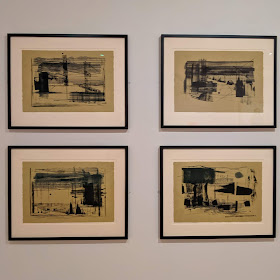From the "Worcester Tree" celebrating the city's businesses and institutions to the "Candy Tree" dripping with (artificial) sweets to the "Tree Spirits" on the Renaissance Court balcony, each creation brings a unique look to brighten our lobbies and galleries.
This year's holiday display was planned and arranged by Sally Jablonski of Herbert E. Berg Florist, with the help of the rest of her staff. Sally has been a friend of the Museum for close to thirty years. WAM contacted her in July to discuss plans to refresh our holiday decorations and expand their presence in the Museum.
 |
| Sally Jablonski and the "Rockin' Music Tree" |
There were many challenges along the way. The "Worcester Tree" is covered with creative ornaments and memorabilia donated by Worcester businesses and organizations, which Sally was gathering right up until a few days before the trees were erected. Meanwhile, she collected every retro item from the 70s and 80s she could find - toys, board games, records, old telephones, comic books and more. "I didn't know how it would all come together," she admits. Working with guest designer Julie Lapham, she created the "Retro Toy Tree" and the "Rockin' Music Tree," a pair of towering artificial pines in Salisbury Hall, framing the corridor leading to the Photo Revolution exhibition which inspired them.
Perhaps the biggest challenge was the "Manzanita Tree, a gold-painted rubber tree dripping with crystal ornaments, designed to stand in the Chapter House. "Almost right away, it started to fall apart from the humidity." Sally took the tree home, recreating it in a smaller (and sturdier) design, and brought it back the next day, ready to display.
 |
| The final version of the "Manzanita Tree" |
Sally says she was largely inspired by her own holiday memories, going to see the Christmas display at Denholm's storefront in downtown Worcester, and spending the holiday at her grandmother's house. She hopes that visitors to WAM will walk away with new holiday memories, and that the trees will bring them joy and fun.
Sally will be returning in January to create an arrangement for WAM's Flora in Winter event; she has been an arranger since the 1990's (when the event was known as Tribute to Flora). Her 2020 arrangement is "still in the idea stage" - she has been paired with a work of art from WAM's collection to interpret through flowers, and is now researching designs and color palettes for inspiration.
We look forward to seeing what she comes up with next!
"Deck the Halls" will be on view through January 5, 2020.
- Sarah Leveille
Digital Media Specialist
December 16, 2019






























